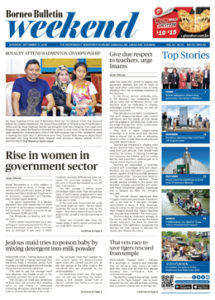ASEAN: Southeast Asia’s term of hiring more women to the government sector

Brunei Darussalam is in sixth position in Southeast Asia in terms of hiring more women to the government sector, an Asian Development Bank (ADB) and Organisation for Economic Cooperation and Development (OECD) report revealed.
The report Government At a Glance: Southeast Asia 2019 stated that the share of women in public-sector employment in the sultanate increased to around 47 per cent between 2009 and 2016.
The Philippines is leading with 53.7 per cent.
Public sector employment as a percentage of total employment for the selected Southeast Asian (SEA) countries was on average 15 per cent in 2016. However, extreme differences exist between the countries ranging from 47 per cent in Brunei Darussalam to six per cent in Myanmar.
The SEA average is almost seven percentage points lower than the average share of public sector employment in total employment in OECD countries, which was 21 per cent in 2016.
.
ADS by Cloud 9:
.
– SPACE RESERVE FOR YOUR ADVERTISEMENT –

.
At the same time, Korea (nine per cent) and Japan (eight per cent) – the two OECD countries for which there is data in the region – have similar shares of public sector employment as half of the SEA countries in 2016.
These two countries also have the lowest share of public sector employment out of all OECD countries.
The public sector in the SEA region is relatively small. In 2016, public employment in the SEA region represented on average 15 per cent of total employment compared to 21 per cent for OECD countries. SEA government expenditures were 20 per cent of gross domestic product (GDP), but 40.6 per cent for the OECD.
Overall, women are well represented in the public sector, but face significant barriers in reaching senior leadership positions; while women’s political representation in Parliament and in ministerial positions could also be improved.
.
ADS by Cloud 9:
.
– SPACE RESERVE FOR YOUR ADVERTISEMENT –

.
There are considerable differences among SEA countries in women’s share in total employment, ranging from 49 per cent in Vietnam to 38 per cent in Malaysia, while women constitute 54 per cent of public sector employment in the Philippines but only 36 per cent in Lao People’s Democratic Republic.
In the political sphere, women are still under-represented in the region. On average, 10 per cent of ministerial posts were filled by women in 2017, compared to 28 per cent in OECD countries. On average, women held 20 per cent of parliamentary seats in SEA countries in 2018, only 1.7 percentage points higher than in 2008. The share of women in Parliament ranges from 30 per cent in the Philippines to five per cent in Thailand.
The joint report, ADB said, saw governments in Southeast Asia strengthening their governance structures and institutional capacity to deliver better services to their people.
.
ADS by Cloud 9:
.
– SPACE RESERVE FOR YOUR ADVERTISEMENT –

.
The Government at a Glance: Southeast Asia 2019 provides internationally comparable data on government resources, processes, and outcomes on public governance in member-countries of the ASEAN. The report covered 34 indicators in areas such as public services, including promoting digital government, creating more transparency, and providing better work opportunities for women.
“Strengthening public institutional capacities is critical to all operations, and ADB remains committed to supporting our developing member-countries in improving public-sector management functions and financial stability, while promoting more effective, timely, corruption-free, and citizen-centric delivery of public services,” said ADB Vice President for Knowledge Management and Sustainable Development Bambang Susantono.
The report also found that seven Southeast Asian countries have introduced digital identification tools and only two have fully integrated their online portals to improve public services and make government services more accessible to the public.
.
ADS by Cloud 9:
.
– SPACE RESERVE FOR YOUR ADVERTISEMENT –

.
Budget transparency, a key component for open government, allows citizens to access information on how public money is raised, allocated and used. All Southeast Asian countries published their approved budget.
The report stated eight countries publish citizens’ guides to the budget, which explain the objectives of the budget and provide information to help citizens understand the budgetting process and assess its impact on their lives.
However, ADB said only half of them provide economic information, such as the methodology and economic assumptions of the fiscal projections supporting the budget.
All countries are working closely with the private sector to build new infrastructure through public-private partnerships, but only half perform relative assessments to evaluate whether PPPs are more efficient than the traditional infrastructure procurement system.
The report suggests further analyses and assessments are needed for informed decision-making to improve infrastructure management./ Azlan Othman
.
ADS by Cloud 9:
.
– SPACE RESERVE FOR YOUR ADVERTISEMENT –

.

All photographs, news, editorials, opinions, information, data, others have been taken from the Internet..aseanews.net









